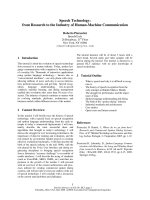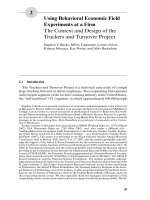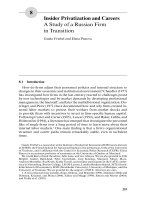From Nuremberg to The Hague - The Future of International Criminal Justice Part 1 pps
Bạn đang xem bản rút gọn của tài liệu. Xem và tải ngay bản đầy đủ của tài liệu tại đây (355.61 KB, 18 trang )
This page intentionally left blank
From Nuremberg to The Hague
The Future of International Criminal Justice
This collection of essays is based on a lecture series organised
jointly by the Wiener Library, Matrix Chambers and
University College London’s Centre for International Courts
and Tribunals betw
een April and June 2002.
The series was
sponsored by the Guardian newspaper. Presented by leading
experts in the field, this fascinating collection of papers
examines the evolution of international criminal justice from
its post-Second World War origins at Nuremberg through to
the concrete proliferation of courts and tribunals with
international criminal law jurisdictions based at The Hague
and Arusha. Original and provocative, the lectures provide
various stim
ulating perspectives on the
subject of
int
ernational criminal law. T
opics include its corporat
e and
historical dimension as well
as a discussion of the Statut
eof
the International
Criminal Court and the role
of national
courts, and offers a challenging insight into the future of
international criminal justice.This is an intelligent and
thought-provoking book, accessible to anyone interested in
international justice, from specialists to non-specialists alike.
is Professor of Laws and Director of
PICT’s Centre for International Courts and Tribunals at
University College London, and a practising barrister at
Matrix Chambers. Contributors include Cherie Booth QC,
Andrew Clapham, James Crawford SC, Richard Overy and
Philippe Sands.
From Nuremberg
to The Hague
The Future of International
Criminal Justice
Edited by
University College London
Cambridge, New York, Melbourne, Madrid, Cape Town, Singapore, São Paulo
Cambridge University Press
The Edinburgh Building, Cambridge , United Kingdom
First published in print format
- ----
- ----
- ----
© Wiener Library 2003
2003
Information on this title: www.cambrid
g
e.or
g
/9780521829915
This book is in copyright. Subject to statutory exception and to the provision of
relevant collective licensing agreements, no reproduction of any part may take place
without the written permission of Cambridge University Press.
- ---
- ---
- ---
Cambridge University Press has no responsibility for the persistence or accuracy of
s for external or third-party internet websites referred to in this book, and does not
guarantee that any content on such websites is, or will remain, accurate or appropriate.
Published in the United States of America by Cambridge University Press, New York
www.cambridge.org
hardback
p
a
p
erback
p
a
p
erback
eBook (EBL)
eBook (EBL)
hardback
Contents
Notes on the contributors page vii
Preface ix
1 The Nuremberg trials: international law
in the making 1
2 Issues of complexity, complicity and
complementarity: from the
Nuremberg trials to the dawn of the
new International Criminal Court 30
3 After Pinochet: the role of national
courts 68
4 The drafting of the Rome Statute 109
5 Prospects and issues for the International
Criminal Court: lessons from Yugoslavia
and Rwanda 157
vi Contents
SC, FBA is Whew
ell Professor of
International
Law and Director of the Lauterpacht Research Cent
re
for International Law,University of Cambridge, as well as a member
of Matrix Chambers. He was a Member of the United Nations
International La
w Commission from 1992 t
o 2001. During that
time, he was responsible for the ILC’s Draft Statute for an
International Criminal Court (1994), which became the initial
negotiating text for the ICC Preparatory Commission.
Subsequently, he was Special Rapporteur on State Responsibility
(1997–2001). He has written and lectured widely on issues of inter-
national criminal law and the ICC. As a member of Matrix
Chambers and Gray’s Inn, he has a substantial practice as counsel
and arbitrator in international courts and tribunals.
is Professor of Modern History at King’s
College London. He has written extensively on the Third Reich and
the Second World War. His books include Russia’s War, Why the
Allies Won, Goering and, most recently, Interrogations: The Nazi Elite
in Allied Hands. He is currently writing a comparative study of the
Hitler and Stalin dictatorships.
is Professor of Laws and Dir
ector of the
Centre for I
nternational Courts and Tribunals at University Co
llege
London. As a practising barrister at Matrix Chambers, he has been
involved in some of the leading cases on international criminal law
before national
and international courts, including the
Pinochet case
in the House of Lords and the Croatia v. Federal Republic of
Yugoslavia case in the International Court of Justice. He served as
legal adviser to the Solomon Islands in the negotiation of the Statute
of the International Criminal Court.
viii Notes on the contributors
Seven months later, on 27 M
ay 1999, President
Slobodan Milosevic of the Federal Republic of
Yugoslavia was indicted by the Prosecutor of the
International Criminal Tribunal for the former
Yugoslavia for atrocities committed in Kosovo.
This
marked the first timethat a serving head of statehad ever
been indicted by an international tribunal.
These three developments, taking place in a period of
less than a year (and which may or may not be
connected), indicated the extent to which the estab-
lished international legal order was undergoing a trans-
formation, and the emergence of a new system of ‘inter-
national criminal law’. They were not spontaneous
occurrences. Rather, they built on developments in
international law over the past fifty years – particularly
in the fields of human rights and humanitarian law –
which reflect a commitment of the international
community to put in place – and to enforce – rules of
international law which would bring to an end
impunity for the most serious international crimes.
In the summer of 2001, informal discussions at the
Wiener Library focused on how to generate greater
public awareness of these developments and of their
implications, which linked the creation of the
International Criminal Court to the epochal trial held
at Nuremberg in 1946 (at which leading figures in the
x Preface
Nazi regime were tried on four counts: of conspiracy,
crimes against peace, war crimes and crimes against
humanity, as defined in Article 6 of the Charter of the
International Military Tribunal). The Wiener Library
had been significantly connected to the Nuremberg
trials: ‘It may be said’, a UN Commissioner wrote in
November 1946,‘that it is thanks to the Wiener Library
that the criminal decrees, regulations, orders and circu-
lars of the Nazi rulers were made known … The help it
has given has been invaluable in the preparation of
charges against the leaders of Nazi Germany.’ After the
trials, Alfred Wiener was offered the papers of the
British prosecution team. In 1995, all but one of the last
sworn and signed statements of the Nuremberg
indictees were donated to the Library.
The Wiener Library then decided that it would be
appropriate to broaden its initiative, leading to the
involvement of Matrix Chambers and University
College London’s PICT Centre for International Courts
and Tribunals. The result was the series of five public
lectures held in London from April to June 2002, organ-
ised around the theme‘From Nuremberg to The Hague:
The Future of International Criminal Justice’.
The five lectures here published trace the historical
and legal developments of international criminal
justice in relation to genocide, war crimes and crimes
Preface xi
against humanity during the past five decades. They
raise a host of questions – political, legal, cultural – on
the delivery of international justice, which are of broad
public importance and public interest. The five lectur-
ers were invited to address their topics in a manner
which would be accessible to the public, and which
would trace developments from the Nuremberg
proceedings to the establishment of the International
Criminal Court, including also the efforts of the inter-
national criminal tribunals for Yugoslavia and Rwanda,
as well as the role of national courts.
The Statute of the International Criminal Court
came into force three weeks after the final lecture, on 2
July 2002. Its judges will be elected in early 2003 and it
will begin to function shortly thereafter.
We would like to thank the numerous individuals
who contributed to the organisation of these lectures,
in particular Noemi Byrd at the PICT Centre and Nick
Martin and Anna Edmundson at Matrix Chambers, as
well as Alan Rusbridger, Ed Pilkington and Marc Sands
at the Guardian newspaper for their support for the
lecture series. We would also like to thank Max du
Plessis and Professor Christine Chinkin for their intel-
lectual contributions, and the distinguished individu-
als who took time out of their busy schedules to chair
individual lectures: David Bean QC, Lord Justice
xii Preface
Stephen Sedley, and Sir Shridath Ramphal QC. We
were gratified by the large public turnout at each of the
lectures, and by the range of interests represented and
questions posed.
Philippe Sands
Professor of Laws, University College London
Barrister, Matrix Chambers
Ben Barkow
Director, Wiener Library
Katharine Klinger
Wiener Library
London, 20 December 2002
Preface xiii
opinion in Britain and the United States was divided on
the right of the victors to bring German leaders before a
court for war crimes. The Nuremberg Military Tribunal
was, as Ley realised, an experiment, almost an improvi-
sation. For the first time the leaders of a major state
were to be arraigned by the international community
for conspiring to perpetrate, or causing to be perpe-
trated, a whole series of crimes against peace and
against humanity.For all its evident drawbacks, the trial
proved to be the foundation of what has now become a
permanent feature of modern international justice.
The idea of an international tribunal to try enemy
leaders for war crimes arrived very late on the scene.
During the war, the Allied powers expected to prosecute
conventional war crimes, from the machine-gunning of
the survivors of sunken ships to the torture of prison-
ers-of-war. For this there already existed legal provision
and agreed conventions. Yet these did not cover the
prosecution of military and civilian leaders for causing
war and encouraging atrocity in the first place. Axis
elites came to be regarded by the Allies as the chief
culprits, men, in Churchill’s words, ‘whose notorious
offences have no special geographical location’.
2
The
2
2
Public Record Office (=PRO), Kew, London, PREM 4/100/10,
note by the Prime Minister, 1 November 1943, p. 2.
greatest difficulty arose over the issue of the treatment
of civilians. Enemy generals and admirals might be
prosecuted as simple war criminals if the case could be
proved that they ordered crimes to be committed. But
civilian leaders were different. There was no precedent
for judicial proceedings against them (the campaign to
‘hang the Kaiser’ in 1919 came to naught, and was in
any event directed at the supreme military commander,
not a civilian head of state).
When the British government began to think about
the issue in 1942, the only realistic solution seemed to be
to avoid a trial altogether and to subject enemy leaders to
a quick despatch before a firing-squad.‘The guilt of such
individuals’, wrote the Foreign Secretary,Anthony Eden,
in 1942,‘is so black that they fall outside and go beyond
the scope of any judicial process.’
3
It was Winston
Churchill,Britain’s wartime prime minister,who arrived
at a solution. He revived the old-fashioned idea of the
‘outlaw’,and proposed that enemy leaders should simply
be executed when they were caught. The idea of
summary execution (at six hours’notice,following iden-
tification of the prisoner by a senior military officer)
became the policy of the British government from 1943
The Nuremberg trials: international law in the making 3
3
PRO, PREM 4/100/10, minute by the Foreign Secretary,
‘Treatment of War Criminals’, 22 June 1942, pp. 2–3.
until the very end of the war.
4
Five years before, in 1938,
outlawry had finally been abolished as a concept in
English law by the Administration of Justice Act.
British preference for summary execution was based
partly on the genuine, but almost certainly mistaken,
belief that public opinion would expect nothing less,and
partly on the fear that a Hitler trial would give the dicta-
tor the opportunity to use the court case as a rallying
point for German nationalism. American lawyers
rehearsed a possible Hitler trial, and found to their
discomfiture that he would have endless opportunity for
making legal mischief,and,at worst,might argue himself
out of a conviction. This would make the trial a mockery,
and earn the incredulous hostility of public opinion.
5
In
America, Churchill won the support of the President,
Franklin Roosevelt, and his hardline Treasury Secretary,
Henry Morgenthau. But opinion in Washington was
divided. The veteran Secretary of War, Henry Stimson,
was opposed to summary justice. He favoured a tribunal
that reflected Western notions of justice:‘notification to
the accused of the charge, the right to be heard, and to
4
4
PRO, PREM 4/100/10, note by the Prime Minister, 1 November
1943, pp. 1–4.
5
NA II, RG 107, McCloy papers, Box 1, Chanler memorandum,
‘Can Hitler and the Nazi Leadership be Punished for Their Acts
of Lawless Aggression?’, n.d. (but November 1944).
call witnesses in his defence.’
6
The War Department
believed that it was important for the Allied war effort to
demonstrate that democratic notions of justice would be
dispensed even for men like Hitler.
The tide was turned from an unusual quarter. In the
Soviet Union, jurists insisted that the full penalty could
only be imposed on German leaders after there had been
a trial. Their experience of the show trials of the 1930s
persuaded them that justice had to be popular, visible
justice. Soviet spokesmen universally expected German
war criminals to be found guilty and executed, as they
had expected purge victims to confess their guilt and be
shot in the Great Terror. American officials who were
keen to avoid the Churchill line latched on to Soviet
insistence on the need for a trial,and an unlikely alliance
of Communist lawyers and American liberals was
mobilised to protest summary justice and to insist on a
judicial tribunal. The argument was clinched only by the
death of Roosevelt. His successor, Harry Truman, a
former small-town judge, was adamant that a trial was
both necessary and feasible.When the major powers met
in San Francisco in May 1945 to set up the United
Nations,the issue was an urgent agenda item.The British
The Nuremberg trials: international law in the making 5
6
NA II, RG 107, Stimson papers, Box 15, Stimson to the
President, 9 September 1944, p. 2.









